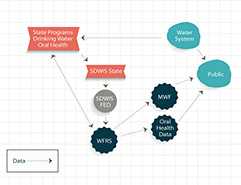Water Fluoridation Reporting System
WFRS Data Stream Infographic

The principal tool by state programs and the CDC to manage the data on water fluoridation is the Water Fluoridation Reporting System
The Water Fluoridation Reporting System (WFRS) is an online tool that helps states manage the quality of their water fluoridation programs. WFRS information is also the basis for national surveillance reports that describe the percentage of the U.S. population on community water systems who receive optimally fluoridated drinking water. The system was developed by CDC in partnership with the Association of State and Territorial Dental Directors (ASTDD).
In July 2011, WFRS version 2.0 was implemented using entirely new program coding, improving the user interface, increasing security and reliability, and simplifying the business logic models. WFRS version 2.1 was implemented in 2013 to improve performance.
Monitoring the Quality of Water Fluoridation
Water systems that adjust the fluoride of their water to the optimal level for decay prevention also collect data to monitor fluoridation quality. This information includes average fluoride concentrations, results of daily testing, and laboratory split sample results. The dates of facility inspections, operator training, and other relevant information also can be included.
State fluoridation managers enter all of these data into WFRS and generate reports that can be used to assure program quality. The following presentation provides a Water Fluoridation Reporting System Overview [PPT–2M] [PDF–1.6M] showing basic application interface features and data organization.
Coordination with the U.S. Environmental Protection Agency (EPA)
The WFRS data strategy and structure was modeled on EPA’s Safe Drinking Water Information System (SDWIS) to support exchange of data and updates on utility system configurations. Each water system in the WFRS database includes basic demographic information, including utility name, address, population served, fluoridation status (e.g., not adjusted, adjusted, natural, variable, or consecutive), natural fluoride concentrations, counties and communities served, system type, and which systems buy or sell water to other systems.
The EPA tracks water systems in its SDWIS database through a unique SDWIS identification number. Using the same identification number for WFRS assures that the information in these two databases can be compared and updated.
Of the water systems listed in SDWIS, approximately 54,000 are identified as community water systems and included in WFRS. About 18,400 community water systems are listed by WFRS as either having fluoride levels that are adjusted, that are naturally occurring, or that are consecutively fluoridated (purchased from a neighboring water system that has optimally fluoridated water).
Access to WFRS Information
The data collected and used in WFRS are provided and owned by the states and tribes. Some states share fluoridation data from WFRS and the fluoridation status of their state via other CDC data applications that have a public access component. Approximately 40 states provide the public with the ability to view the fluoride content of community water systems on CDC’s My Water’s Fluoride. My Water’s Fluoride allows consumers in participating states to learn basic information about their community water system, including the number of people served by the system and the fluoride level.
Consumers also can learn the fluoride content of their water systems by contacting their local water utility service.
WFRS is an authenticated (password-protected) application requiring approved users to enter a passcode to access the application. Employees of state oral health and drinking water programs can be granted permission to use the WFRS database.
An interactive graphic on How CDC Water Fluoridation Data Systems Relate to WFRS displays the relationship of CDC data applications with respect to public access of WFRS data.
Water Fluoridation Quality Awards
Based on WFRS data, CDC issues Water Fluoridation Quality Awards to recognize those water systems that adjust the fluoride concentration in drinking water and achieve a monthly average fluoride level that is within the optimal range for 12 consecutive months in a calendar year. This represents a high level of operator care and accomplishment. Providing a consistent level of fluoride in water ensures the benefit of preventing tooth decay.
EPA, many state drinking water programs, and some professional associations related to the drinking water industry have quality award programs, and many water utilities strive to qualify for these awards.
- Page last reviewed: July 1, 2016
- Page last updated: October 6, 2016
- Content source:


 ShareCompartir
ShareCompartir